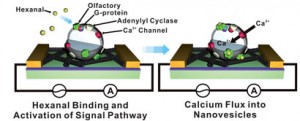Check out some of the HOT articles published last month in Analyst that you may have missed. These papers will be free to access for 2 weeks!
13C cell wall enrichment and ionic liquid NMR analysis: progress towards a high-throughput detailed chemical analysis of the whole plant cell wall
Marcus Foston, Reichel Samuel and Arthur J. Ragauskas
Analyst, 2012, 137, 3904-3909
DOI: 10.1039/C2AN35344J
Transmission Raman measurement directly through packed corn kernels to improve sample representation and accuracy of compositional analysis
Kayeong Shin, Hoeil Chung and Chul-won Kwak
Analyst, 2012, 137, 3690-3696
DOI: 10.1039/C2AN35443H
A water soluble Al3+ selective colorimetric and fluorescent turn-on chemosensor and its application in living cell imaging
Supriti Sen, Titas Mukherjee, Basab Chattopadhyay, Anuradha Moirangthem, Anupam Basu, Jaromir Marek and Pabitra Chattopadhyay
Analyst, 2012, 137, 3975-3981
DOI: 10.1039/C2AN35560D
Silylated BODIPY dyes and their use in dye-encapsulated silica nanoparticles with switchable emitting wavelengths for cellular imaging
Xuehua Hong, Zhuyuan Wang, Jing Yang, Qingdong Zheng, Shenfei Zong, Yu Sheng, Deqin Zhu, Changquan Tang and Yiping Cui
Analyst, 2012, Advance Article
DOI: 10.1039/C2AN35389J
Fourier transform infrared imaging analysis in discrimination studies of squamous cell carcinoma
J. D. Pallua, C. Pezzei, B. Zelger, G. Schaefer, L. K. Bittner, V. A. Huck-Pezzei, S. A. Schoenbichler, H. Hahn, A. Kloss-Brandstaetter, F. Kloss, G. K. Bonn and C. W. Huck
Analyst, 2012, 137, 3965-3974
DOI: 10.1039/C2AN35483G
Fabrication of glutathione photoelectrochemical biosensor using graphene–CdS nanocomposites
Xiaomei Zhao, Shiwei Zhou, Qingming Shen, Li-Ping Jiang and Jun-Jie Zhu
Analyst, 2012, 137, 3697-3703
DOI: 10.1039/C2AN35658A
BODIPY based colorimetric fluorescent probe for selective thiophenol detection: theoretical and experimental studies
Dnyaneshwar Kand, Pratyush Kumar Mishra, Tanmoy Saha, Mayurika Lahiri and Pinaki Talukdar
Analyst, 2012, 137, 3921-3924
DOI: 10.1039/C2AN35524H
Quantification of low-polar small molecules using room temperature ionic liquids matrix-assisted desorption corona beam ionization
Hua Wang, Yongning Wu, Bin Guo, Wenjian Sun, Li Ding and Bo Chen
Analyst, 2012, 137, 3982-3988
DOI: 10.1039/C2AN35508F
Silver nanoparticle aggregates on copper foil for reliable quantitative SERS analysis of polycyclic aromatic hydrocarbons with a portable Raman spectrometer
Xiaohong Jiang, Yongchao Lai, Min Yang, Heng Yang, Wei Jiang and Jinhua Zhan
Analyst, 2012, 137, 3995-4000
DOI: 10.1039/C2AN35713E
A BODIPY-functionalized bimetallic probe for sensitive and selective color-fluorometric chemosensing of Hg2+
Hyunjong Son, Ji Ha Lee, Yang-Rae Kim, In Su Lee, Sanyang Han, Xiaogang Liu, Justyn Jaworski and Jong Hwa Jung
Analyst, 2012, 137, 3914-3916
DOI: 10.1039/C2AN35704F















